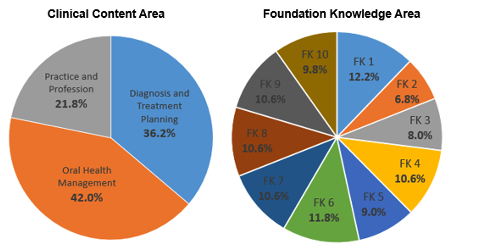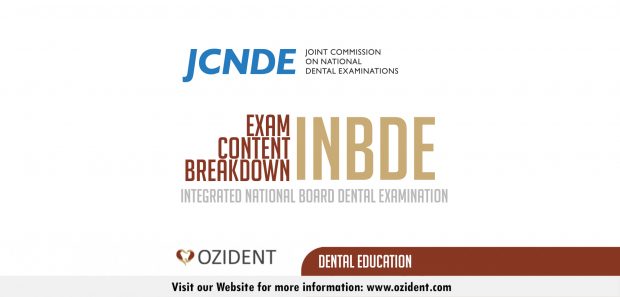This article will explain the exam content for the new INBDE and the time frame.
Time Breakdown
INBDE is a two-day examination with a total of 500 total items:
- Day 1: It should be taken on a Computer and comprises 360 test items – 3 sets of 100 items and 1 set of 60 case questions.
 Day 2 consists of 140 test items comprising 2 sets of 70 case questions.
Day 2 consists of 140 test items comprising 2 sets of 70 case questions.
INBDE Exam Content Breakdown
The Domain of Dentistry The INBDE® was designed to integrate the biomedical, clinical, and behavioral sciences to evaluate candidate dental cognitive skills. This integration occurs through the Domain of Dentistry, which serves as the content domain for the INBDE. The Domain of Dentistry represents the Clinical Content areas and Foundation Knowledge areas required for the safe, independent, general practice of dentistry by entry-level practitioners. It contains 56 Clinical Content (CC) and 10 Foundation Knowledge (FK) areas. Through this approach, the clinical relevance of examination content is maximized. The Domain of Dentistry serves as the key reference for the INBDE test specifications, which indicate the percentage of items allocated to topic areas.

Clinical Content Areas
INBDE® Clinical Content areas represent the fundamental tasks that entry-level general practitioners perform. These areas are grouped into Diagnosis and Treatment Planning, Oral Health Management, and Practice and Profession. Each Group will have crossed with a percentage from each Foundation knowledge area.
1. Diagnosis and Treatment Planning includes all aspects of diagnosis, assessment, interpretation of laboratory results, physical evaluation of structure, appearance, and function, as well as background, characteristics, circumstances, underlying conditions, and psychological, social, or behavioral influences to derive an accurate diagnosis and treatment plan, as well as reasonable and safe treatment alternatives for any patient. Within the Joint Commission’s Domain of Dentistry, Diagnosis and Treatment Planning is represented by the tasks below:
-
- Interpret patient information and medical data to assess and manage patients.
- Identify the chief complaint and understand the contributing factors.
- Perform head neck, and intraoral examinations, interpreting and evaluating the clinical findings.
- Use clinical and epidemiological data to diagnose and establish dental abnormalities and pathology prognosis.
- Recognize the normal range of clinical findings and distinguish significant deviations that require monitoring, treatment, or management.
- Predict the most likely diagnostic result given available patient information.
- Interpret diagnostic results to inform understanding of the patient’s condition.
- Recognize the manifestations of systemic disease and how the disease and its management may affect the delivery of dental care.
- Recognize the interrelationship between oral health and systemic disease and implement strategies for improving overall health.
- Select the diagnostic tools most likely to establish or confirm the diagnosis.
- Collect information from diverse sources (patient, guardian, patient records, allied staff, and other healthcare professionals) to make informed decisions.
- Formulate a comprehensive diagnosis and treatment plan for patient management.
- Discuss etiologies, treatment alternatives, and prognoses with patients so they are educated and can make informed decisions concerning their care management.
- Understand how patient attributes (e.g., gender, age, race, ethnicity, and special needs), social background, and values influence the provision of oral health care at all stages of life.
- Interact and communicate with patients using psychological, social, and behavioral principles.
2. Oral Health Management includes all aspects of patient care delivery, including provision and modification of treatment, handling of complications, intervention outcomes assessment, and all developments that arise while managing a patient’s oral health care. Within the Joint Commission’s Domain of Dentistry, Oral Health Management is represented by the tasks below.
- Prevent, recognize, and manage medical emergencies (e.g., cardiac arrest).
- Prevent, recognize, and manage dental emergencies.
- Recognize and manage acute pain, bleeding, trauma, and infection of the orofacial complex. 19 Prevent, diagnose, and manage pain during treatment.
- Prevent, diagnose, and manage pulpal and peri-radicular diseases.
- Prevent, diagnose, and manage caries.
- Prevent, diagnose, and manage periodontal diseases.
- Prevent, diagnose, and manage oral mucosal and osseous diseases.
- Recognize, manage, and report patient abuse and neglect.
- Recognize and manage substance abuse.
- Select and administer or prescribe pharmacological agents in the treatment of dental patients.
- Anticipate, prevent, and manage complications arising from therapeutic and pharmacological agents in patient care.
- Diagnose endodontic conditions and perform endodontic procedures.
- Diagnose and manage the vital needs of edentulous and partially edentulous patients.
- Restore tooth function, structure, and esthetics by replacing missing and defective tooth structures while promoting soft and hard tissue health.
- Perform prosthetic restorations (fixed or removable) and implant procedures for partially edentulous patients.
- Diagnose and manage oral surgical treatment needs.
- Perform oral surgical procedures.
- Prevent, diagnose, and manage developmental or acquired occlusal problems.
- Prevent, diagnose, and manage temporomandibular disorders.
- Diagnose and manage patients requiring modification of oral tissues to optimize form, function, and esthetics.
- Evaluate outcomes of comprehensive dental care. 38 Manage the oral esthetic needs of patients.
3. Practice and Profession include the understanding, implementation, and monitoring of practical systems, procedures, and policies that support professional practice integrity, quality control, and self or organizational performance assessment, as well as systems, procedures, and policies that enable skillful integration of new knowledge, products, and technology, and that minimize risk and enhance the quality of care provided or improve community oral health. Within the Joint Commission’s Domain of Dentistry, Practice and Profession are represented by the tasks below.
- Evaluate and integrate emerging trends in health care.
- Evaluate social and economic trends and adapt to accommodate their impact on oral health care. 41 Evaluate scientific literature and integrate new knowledge and best research outcomes with patient values and other sources of information to make treatment decisions.
- Practice within the general dentist’s scope of competence and consult with or refer to professional colleagues when indicated.
- Evaluate and utilize available and emerging resources (e.g., laboratory and clinical resources, information technology) to facilitate patient care, practice management, and professional development.
- Conduct practice activities that manage risk and are consistent with jurisprudence and ethical requirements in dentistry and healthcare.
- Recognize and respond to situations involving ethical and jurisprudence considerations.
- Maintain patient records per jurisprudence and ethical requirements.
- Conduct practice-related business activities and financial operations per sound business practices and jurisprudence (e.g., OSHA and HIPAA).
- Develop a catastrophe preparedness plan for the dental practice.
- Manage, coordinate, and supervise the activity of allied dental health personnel.
- Assess one’s level of skills and knowledge relative to dental practice.
- Adhere to standard precautions for infection control for all clinical procedures.
- Use prevention, intervention, and patient education strategies to maximize oral health.
- Collaborate with dental team members and other health care professionals to promote health and manage community disease.
- Evaluate and implement systems of oral health care management and delivery that will address the needs of the patient populations served.
- Apply quality assurance, assessment, and improvement concepts to improve outcomes.
- Communicate case design to laboratory technicians and evaluate the resultant restoration or prosthesis.
Foundation Knowledge (FK)
Areas Within the Domain of Dentistry, Foundation Knowledge (FK) Areas represent the knowledge, skills, and abilities required to successfully perform tasks in the aforementioned Clinical Content Areas. The dentist applies Knowledge in each area to aid in the prevention, diagnosis, and management of oral disease and promote and maintain oral health. The Domain of Dentistry Foundation Knowledge areas are as follows:
- FK1: Molecular, biochemical, cellular, and systems-level development, structure and function
- FK2: Physics and chemistry to explain normal biology and pathobiology
- FK3: Physics and chemistry to describe the characteristics and use of technologies and materials
- FK4: Principles of genetic, congenital, and developmental diseases and conditions and their clinical features to understand patient risk
- FK5: Cellular and molecular bases of immune and non-immune host defense mechanism.
- FK6: General and disease-specific pathology to assess patient risk
- FK7: The biology of microorganisms in physiology and pathology
- FK8: Pharmacology
- FK9: Behavioral sciences, ethics, and jurisprudence
- FK10: Research methodology and analysis and informatics tools.
Test specifications
Test specifications provide information concerning how examination questions (items) are allocated across content domain areas. The INBDE test specifications are given in the table below. These specifications show the percentage of examination items assigned to each clinical component section and each Foundation Knowledge Area. The table also shows how items are allocated within each section and area.

This means there will be minimal (almost none ) questions in practice and profession related to FK1: Molecular, biochemical, cellular, and systems-level development, structure, and function but will have at least 5% related to FK9: Behavioral sciences, ethics, and jurisprudence
